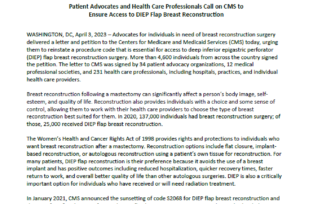In September 2022, the Food and Drug Administration – the government agency that, among other responsibilities, oversees which medicines and medical devices are available in the United States – issued a safety communication about a known connection between breast implants and certain types of cancer.

(GETTY IMAGES)
While the FDA noted that the cancers it was highlighting are rare, “because this is an emerging issue and our understanding is evolving, the FDA asks health care professionals and people with breast implants to report cases of squamous cell carcinoma, lymphomas or any other cancers around breast implants to the FDA.”
If you’re considering getting breast implants, whether for gender-affirming care, to reconstruct the breast after surgery for breast cancer or trauma or for aesthetic reasons, this warning may seem frightening. Here’s what you need to know about breast implant safety.
Types of Implants
“Breast implants offer patients the option to enhance the size of their breasts (and) improve contour, projection and symmetry,” explains Dr. Linda L. Zeineh, a board-certified reconstructive plastic surgeon with Providence St. Joseph Hospital Center for Cancer Prevention and Treatment in Orange, California.
There are two main types of implants:
- Saline. “Saline breast implants have an outside shell composed of silicone, and the inside is filled with salt water or saline through a small port,” says Dr. Glenn Vallecillos, a plastic surgeon in private practice in Beverly Hills, California, and a diplomate of the American Board of Plastic Surgery. “Because of this, small volume adjustments can be made during surgery with saline implants, making them more versatile than their silicone counterparts, which are produced in predetermined volumes.” In addition, he says, saline implants “tend to be less expensive than silicone implants.”
- Silicone. These implants, on the other hand, are filled with a silicone gel that’s also housed within a silicone shell. The gel is thicker than saline, which offers “a more natural feel than that of saline implants,” Vallecillos says. “Most contemporary silicone implants utilize cohesive silicone gel, which helps the implant mimic a more natural breast shape.”
Risks of Implants
Both types of implants have been deemed safe for use by the FDA. However, “there are inherent risks with both type of implants,” Vallecillos says. Complications can include:
Any kind of breast implant can rupture, particularly if you’ve sustained injury or trauma to the torso, like during an auto accident.
Vallecillos says that silicone implants are more likely to rupture without showing any symptoms. “This is due to the chemical makeup of the silicone used to fill implants,” he says. The viscosity of the silicone means that leaks can be harder to detect, and you’ll need to undergo an MRI to definitively diagnose a rupture.
“In many instances, the ruptured implant retains most of the fluid within the implant shell, although any disruption of the implant shell will, over time, lead to local tissue contamination,” Vallecillos says. If that happens, you may need to have the contaminated breast tissue removed. In some rare cases, patients may develop an immune system response as well as pain or discomfort.
When a saline implant ruptures, on the other hand, it’s usually immediately obvious because the breast deflates noticeably. Saline is not harmful to the body, and the breast tissue quickly absorbs and metabolizes the saline, Vallecillos explains. “There will be immediate signs of external changes in the size and shape of the breast,” he says. “The patient may also experience pain and/or discomfort in some cases.”
In either case, “if a breast implant rupture is suspected, follow-up with a plastic surgeon is recommended,” Vallecillos says. If a rupture has occurred, the implant will have to be removed. The sooner that happens, the better, to prevent further complications.
Capsular contracture
Capsular contracture is a tightening of the scar tissue that forms immediately around the implant. While the development of scar tissue itself is completely normal, this hardening can make the breast feel firm to the touch and may cause chronic discomfort or pain. It can also restrict your range of motion, or make the breast rise higher on the chest.
People who’ve had radiation therapy at any point in their past, but particularly right after surgery for breast cancer, are at higher risk of developing capsular contracture.
If capsular contracture occurs, you’ll likely have to have the implant removed. Your doctor may be able to perform a revision surgery that puts a new implant, coated with a special collagen material to help prevent future hardening of scar tissue, back into the chest. But the options for reconstruction after capsular contracture will be dependent on the specifics of the case.
The recent concerns around breast implants have “stemmed from research that found people with certain types of breast implants are at risk of developing breast implant-associated anaplastic large cell lymphoma (BIA-ALCL),” explains Dr. Colleen McCarthy, an attending plastic surgeon with Memorial Sloan-Kettering Cancer Center and a member of the American Society of Plastic Surgeons. “This is not a breast cancer, but rather a cancer affecting the body’s immune system.”
This type of cancer has been detected in people who have silicone gel and saline-filled implants, but it was “almost exclusively discovered among people with implants that have a textured or rough surface (in comparison to those with a smooth surface),” McCarthy explains. In response to that finding, in 2019, textured breast implants produced by the Allergan company were recalled from the market.
McCarthy adds, “The FDA has suggested there is no association between breast implants and connective tissue disease or autoimmune disease, but studies to evaluate these are ongoing.”
Reducing Risks
“Women with breast implants should know how to recognize potential problems associated with their implants,” says Dr. Andrea Pusic, chief of the division of plastic surgery with Brigham and Women’s Hospital and the Joseph E. Murray Professor of Surgery at Harvard Medical School in Boston. Look out for any new changes around a breast implant, including:
- Breast swelling.
- A lump in the breast or armpit.
- New, persistent breast pain.
These and any other new changes should be investigated by a care provider, she says.
You should also make sure to check in with your plastic surgeon on a schedule that they recommend, usually four to six weeks after the initial surgery, and then annually to make sure everything looks good. If you experience trauma that could have damaged the implant, you should check in with your doctor about additional follow-ups to ensure that the implant is still intact.
One of the key things to remember about any breast implant is that it’s not intended to last a lifetime.
“Breast implant surgery, whether for primary breast augmentation or enhancement related to reconstructive surgery, is a long-term commitment,” Vallecillos says. “Most women who undergo breast enhancement early in life can expect to undergo multiple breast surgeries throughout the course of their lives. This is a reality that warrants consideration.”
Pusic, who is also a member of the American Society of Plastic Surgeons, agrees that people with implants will need to take care of them over time. “Breast implants are (medical) devices that require long-term surveillance. While we don’t ‘remove and replace’ implants routinely every 10 years as we once did, it’s not uncommon for women to require future surgeries.”
No matter what type of implant you have, your doctor will want to monitor how they’re holding up over time. Because ruptures of silicone implants can be harder to detect, “the FDA recommends either ultrasound or MRI starting five years after implantation with repeat imaging every three years thereafter,” Pusic says.
She also notes that before you get implants, talk with your doctor about the U.S. National Breast Implant Registry, which she calls “an important national effort to improve breast implant safety and surveillance.”
Ask if your surgeon is participating in the registry, and if so, request to be included.
“In addition, when selecting a surgeon for breast implant surgery, look for a plastic surgeon certified by the American Board of Plastic Surgery,” Pusic says.
Saline vs. Silicone vs. Other Options
So, is saline better? Or silicone? Is one safer than the other? McCarthy says there is no evidence to suggest that either saline or silicone implants are safer than the other.
Vallecillos also notes that implants aren’t the only way to change the appearance of the breasts. Natural breast augmentation, or autologous reconstruction, involves transferring fat from another part of the body into the chest to reconstruct or enhance the shape and size of the breast. For the right patient, this approach “provides an excellent alternative to breast enhancement with implants.”
One particular type of autologous breast reconstruction that’s used widely in treating breast cancer is the DIEP (deep inferior epigastric perforator) flap reconstruction. In this procedure, the surgeon moves fat typically from the belly or buttocks and uses it to rebuild the breast after mastectomy.
However, a recent change to how the procedure is coded for insurance companies has led to a decrease in reimbursement for the more complex DIEP flap reconstruction. That has made it more difficult for some people to access this type of care.
“Many women want to have a natural reconstruction that doesn’t involve a foreign body,” says Dr. Elisabeth Potter, a board-certified plastic surgeon in Austin, Texas, who specializes in breast reconstruction surgery. Unlike with implants, reconstructions that use the person’s own tissue “last a lifetime, and they don’t sign you up for repeated surgeries,” she adds. “I think a lot of women these days have heard about the safety risks associated with implants. While they’re rare, there is an increased awareness that there can be complications with them.”
There’s another trade-off, too. DIEP flap reconstruction surgeries are more complicated and take longer to heal. They also leave scars not only where the tissue is deposited to build a new breast, but also at the site where the fat was harvested.
Making the Decision
Potter cautions that folks who will be undergoing radiation treatment as part of their breast cancer care protocol “should be counseled regarding the increased risk of reconstruction failure, capsular contracture, infection and asymmetry associated with an implant. Even the FDA says that implants are not meant to be used in a setting of tissue that has been or will be irradiated.”
In the end, the decision for how to augment or reconstruct a breast is an entirely personal one that you should talk through carefully with your surgeon. Your provider can weigh the specifics of your case and help you make an informed decision that’s right for you.
“Women facing cancer deserve clear messaging that’s not biased,” Potter says. “They should be counseled regarding reconstruction in a clear way that offers all types of reconstruction and accurate information.” And then, with that information provided, the decision lies with the patient.
Potter adds that if an autologous reconstruction is right for you, but you’re having trouble getting it covered, “find a doctor who’s willing to do the surgery through insurance,” even if that means accepting a lower fee. There are some surgeons out there, like Potter, who do that. She also recommends contacting your insurance company and asking what they can do to assist.
The U.S. News Health team delivers accurate information about health, nutrition and fitness, as well as in-depth medical condition guides. All of our stories rely on multiple, independent sources and experts in the field, such as medical doctors and licensed nutritionists. To learn more about how we keep our content accurate and trustworthy, read our editorial guidelines.
Colleen McCarthy, MD, FRCSC
McCarthy is an attending plastic surgeon with Memorial Sloan-Kettering Cancer Center and a member of the American Society of Plastic Surgeons.
Elisabeth Potter, MD
Potter is a board-certified plastic surgeon in Austin, Texas, who specializes in breast reconstruction surgery.
Andrea Pusic, MD, MHS, FRCSC, FACS
Pusic is chief of the division of plastic surgery with Brigham and Women’s Hospital and the Joseph E. Murray Professor of Surgery at Harvard Medical School in Cambridge, Massachusetts.
Glenn Vallecillos, MD, FACS
Vallecillos is a plastic surgeon in private practice in Beverley Hills, California, and a diplomate of the American Board of Plastic Surgery.
Linda L. Zeineh, MD, FACS
Zeineh is a board-certified reconstructive plastic surgeon with Providence St. Joseph Hospital Center for Cancer Prevention and Treatment in Orange, California.






